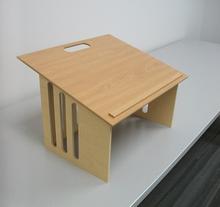
By Seth Bauguess
Next fall, sharp-eyed Wright State University students may notice a change at the head of the classroom: smaller, lighter tabletop podiums in place of the heavier, mismatched podiums that professors have lectured from for decades.
The project began back in 2012 when word from faculty began to surface that many of the older podiums were in disrepair and not as functional in classrooms settings that increasingly needed to be flexible.
“Our podiums were old, cumbersome and just didn’t match,” said Debbie Whisler, supervisor of classroom technology support. “We began gathering information for a solution.”
The Classroom Technology Support department within Computing and Telecommunications Services (CaTS) took the challenge and found an answer when Mateen Rizki, Ph.D., engineering professor and chair of the Department of Computer Science and Engineering, suggested that engineering students working on their senior design projects might be able to help.
Engineering students investigated usability characteristics known as human factors and surveyed faculty for design input. Eighty designs were trimmed to five finalists. In the end, faculty members chose the design they felt would work best. They felt the design by engineering graduate Trent Williams ’14 was the best solution.
“This collaborative approach to solving university issues by engaging with different service departments as well as academic departments is something I hope continues across campus,” said Whisler.
So far 15 prototypes are being used, but the goal is to collect feedback from faculty and students before replacing all of the old podiums by the end of the Summer Semester.
Faculty, staff or students can share their feedback about the prototypes by emailing helpdesk@wright.edu.
Local woodworking company Cassidy Woodworks has been commissioned to build the podiums.
“This was such a satisfying project because we saw the benefits of getting students engaged in solving real-world problems, but at the same time we worked with faculty and staff to deliver a solution that works for them too,” said Whisler.

